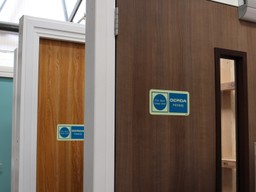Fire Safety for Flats: The Regulations and Best Practices
Fire safety is a crucial consideration for flats and other residential buildings. Whether you’re a resident, building manager, or property owner, understanding the essential elements of fire safety can save lives and ensure compliance with regulations. This guide to fire safety for flats outlines key principles, identifies practical steps you can take, and offers expert… Continue reading Fire Safety for Flats: The Regulations and Best Practices
Fire safety is a crucial consideration for flats and other residential buildings. Whether you’re a resident, building manager, or property owner, understanding the essential elements of fire safety can save lives and ensure compliance with regulations.
This guide to fire safety for flats outlines key principles, identifies practical steps you can take, and offers expert advice to help you keep your building safe.
Key Takeaways
- Compartmentation is vital to prevent fire spread between flats.
- The ‘Stay put’ strategy: Occupants of unaffected flats to remain inside unless instructed to evacuate.
- Fire doors and alarms: Regular inspections are legally required.
- Fire risk assessments: Ongoing evaluations help identify and mitigate risks.
- High-rise buildings need additional safety measures like sprinklers and accountable persons.
Why Fire Safety Is Vital in Flats
Flats pose unique challenges in fire safety due to their design. Unlike standalone homes, flats rely on systems like compartmentation, fire doorsets, and communal escape routes to contain and control fires. Without these systems, even small incidents can escalate quickly, putting many lives at risk.
High-rise fire safety demands even stricter standards. Taller buildings must account for longer evacuation times, increased fire spread risk, and the complexities of firefighting in multi-storey environments. For residents, understanding these risks and the safety measures in place is critical to protecting themselves and their neighbours.
Core Principles of Fire Safety for Flats
Compartmentation
Each flat is designed to function as a self-contained fire-resisting compartment. This principle ensures that fires remain confined to their origin, giving occupants time to evacuate safely.
- Fire-resistant walls and ceilings prevent spread.
- Fire doorsets at flat entrances act as barriers to smoke and flames.
- Inspections by certified professionals ensure these barriers remain effective.
For more details on the importance of flat entrance doors to fire safety, explore our guide to fire doors for flats.
The ‘Stay Put’ Strategy
The ‘stay put’ strategy relies on compartmentation to maintain fire safety for flats. If your flat isn’t directly affected, staying inside can often be safer than evacuating, as communal escape routes might be hazardous during a fire.
When Should You Evacuate?
- If a fire occurs in your flat.
- If the fire service explicitly advises evacuation.
Properly maintained fire doorsets and alarms ensure that this strategy remains effective. Advanced fire doorsets can provide added protection.
Fire Risk Assessments: A Legal Requirement
Fire risk assessments are a cornerstone of fire safety for residential buildings. They identify potential hazards, evaluate safety measures, and provide actionable recommendations.
What Does a Fire Risk Assessment Include?
- Identification of ignition sources and combustible materials.
- Review of fire doorsets, smoke alarms, and escape routes.
- Inspection of communal areas for obstructions.
- Compliance checks for updated fire safety regulations.
Building owners or designated “responsible persons” are legally required to carry out these assessments. Residents should report concerns to ensure their building remains compliant.
Fire Doors: Essential Barriers Against Fire Spread
Flat entrance fire doorsets play a vital role in containing fires. Legally, these doors must meet strict specifications for fire safety for residential buildings. This includes a minimum FD30 rating, which provides 30 minutes of fire resistance.
Key Features of Fire Doorsets
- Self-closing mechanisms to ensure doors remain shut.
- Intumescent strips and smoke seals to block smoke and heat.
- Fire-rated hinges for added durability under high temperatures.
From January 2023, regulations require quarterly checks of fire doorsets in communal areas and biannual checks for flat entrance doors. Misusing or propping open fire doors is not only unsafe but also subject to legal penalties under the Regulatory Reform (Fire Safety) Order 2005.
Smoke Alarms and Sprinkler Systems
Effective fire safety systems start with early detection. Smoke alarms and sprinklers are essential for minimising fire damage and preventing loss of life.
Smoke Alarm Recommendations
- Interlinked mains-powered smoke alarms are preferred for flats.
- Heat detectors should be installed in kitchens to reduce false alarms.
- Test alarms monthly to ensure functionality.
Sprinkler Systems in High-Rise Buildings
Since 2022, all new residential blocks over 11 metres in height must have sprinkler systems installed. These systems are especially critical for fire safety for flats in high-rise settings, where firefighting access may be delayed.
Keeping Communal Areas Safe
Escape routes like hallways and stairways must always remain clear. Even small obstructions can become deadly in an emergency.
Tips for Maintaining Safe Communal Areas
- Remove combustible items such as furniture or decorations.
- Report blocked or locked fire exits immediately.
- Regularly inspect lighting and signage along escape routes.
Residents and building managers share responsibility for ensuring these areas remain safe and accessible.
Modifications and Their Impact on Fire Safety
Altering a flat or building without proper approvals can compromise fire safety. Before making any changes, consult your landlord or local building control to ensure compliance.
Examples of Risky Modifications
- Replacing a certified fire door with a standard door.
- Adding partitions or walls that disrupt escape routes.
- Installing materials that aren’t fire-resistant.
Legal penalties for non-compliance are severe, and unauthorised changes could void insurance claims in case of a fire.
Special Considerations for High-Rise Fire Safety
High-rise buildings (over 18 metres or seven storeys tall) require additional precautions due to their complexity.
- Firefighting equipment must be regularly inspected.
- An accountable person must oversee safety measures.
- Enhanced escape plans should account for longer evacuation times.
By following these principles and staying informed, residents and building managers can work together to ensure that flats remain safe, compliant, and prepared for any fire-related emergencies.
For tailored advice on fire safety, learn more about our residential fire safety projects.
FAQs About Fire Safety for Flats
Are fire doorsets mandatory in flats?
Yes, all flat entrance doorsets leading to communal areas must meet fire-resistance standards.
How often should smoke alarms be tested?
Monthly testing is recommended to ensure proper functionality.
What should I do if my building’s fire escape routes are blocked?
Report it immediately to your building manager or landlord.
Are UPVC doors acceptable as fire doorsets?
No, UPVC doors do not meet fire safety standards.
What is compartmentation in fire safety?
Compartmentation involves designing each flat as a fire-resistant unit to contain fires and prevent spread.



